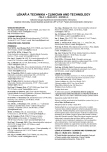Objektivní měření únavy frekvencí mrkání
Authors:
Richard Rokyta 1; Jiří Pučelík 2; Jan Dudák 1,3; Anna Yamamotová 1
Authors‘ workplace:
Univerzita Karlova v Praze, 3. lékařská fakulta
Ústav normální, patologické a klinické fyziologie, Praha
1; Program Projekt s. r. o., Plzeň
2; České vysoké učení technické v Praze, Fakulta biomedicínského inženýrství
Katedra přírodovědných oborů, Praha
3
Published in:
Lékař a technika - Clinician and Technology No. 3, 2013, 43, 14-18
Category:
Original research
Overview
In the article, the new possibility of registration of fatigue is described. The optoelectronic apparatus records the eye-blink rate which serves as an objective indicator of person’s fatigue, especially at night. The results show that frequency of eye-blink rate is faster in the night than in the day. Described method can be used in drivers, which will be informed by warning acoustic signal about the risk of falling asleep when the frequency of eye-blink will reach individually critical level.
Keywords:
eye-blink rate monitoring, fatigue, car drivers
Sources
1. Barbato, G., De Padova, V., Paolillo, A. R., Arpaia, L., Russo, E., Ficca, G. Increased spontaneous eye blink rate following prolonged wakefulness. Physiology & Behavior 2007; 90:151–154.
2. Barbato, G., Ficca, G., Muscettola, G., Fichele, M., Beatrice, M., Rinaldia, F. Diurnal variation in spontaneous eye-blink rate. Psychiatry Research 2000; 93:145-151.
3. Boverie, S., Giralt, A. Driver vigilance diagnostic based on eyelid movement observation. Proceedings of the 17th World Congress, The International Federation of Automatic Control Seoul, Korea, 2008; 12831-12836.
4. Eisenberg, D. P., Kohn, P. D., Baller, E. B., Bronstein, J. A., Masdeu, J. C., Berman, K. F. Seasonal effects on human striatal presynaptic dopamine synthesis. J Neurosci. 2010; 30:14691-14694.
5. Faber, J., Pěkný, J., Pieknik, R., Tichý, T., Faber, V., Bouchner, P., Novák, M. Simultaneous recording of electric and metabolic brain activity, Neural Network World 2010; 20:539-557.
6. Faber, J., Novák, M. Thalamo-cortical reverberation in the brain produces alpha and delta rhythms as iterative convergence of fuzzy cognition in a stochastic environment. Neural Network World 2011; 21:169-192.
7. Heitmann, A., Guttkuhn, R., Aguirre, A., Trutschel, U., Moore-Ede, M. Technologies for the monitoring and prevention of driver fatigue. Proceedings of the First International Driving Symposium on Human Factors in Driver Assessment, Training and Vehicle Design 2001; 81-86.
8. Lal, S. K. L., Craig, A. A critical review of the psychophysiology of driver fatigue. Biological Psychology 2001; 55:173–194.
9. Macaš, M., Vavrečka, M., Gerla, V., Lhotská, L. Classification of the emotional states based on the EEG signal processing, Proceedings of 9th International Conference on Information Technology and Applications in Biomedicine [CD-ROM]. Piscataway: IEEE, 2009.
10. Philipp, P., Caffier, P. P., Erdmann, U., Ullsperger, P. Experimental evaluation of eye-blink parameters as a drowsiness measure. Eur J Appl Physiol 2003; 89:319–325.
11. Stern JA, Boyer D, Schroeder D. Blink rate: A possible measure of fatigue. Human Factors 1994; 36:285-297.
12. Sýkora, O., Novotný, S., Bouchner, P. Objective Assessment of Drivers Performance Impaired by Drowsiness. In: Advances in Sensors, Signals, Visualization, Imaging and Simulation. Athens: WSEAS Press, 2012, vol. 1, p. 259-263.
13. Verwey, W. B., Zaidel, D. M. Predicting drowsiness accidents from personal attributes, eye blinks and ongoing driving behaviour. Personality and Individual Differences 2000; 28:123-142.
Labels
BiomedicineArticle was published in
The Clinician and Technology Journal

2013 Issue 3
Most read in this issue
- Objektivní měření únavy frekvencí mrkání
- Detekce pulsačních změn průměru tepen v dynamickém ultrazvukovém obraze
- Studium mechanických vlastností s využitím mikroskopie atomárních sil
- The Influence of the Skin Fatigue, its Perspiration and the Time of Stimulation in Measurement of the Active Points on Human Skin
